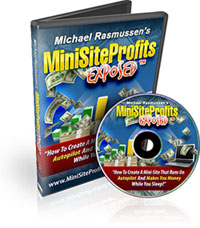Developing a Link Strategy For Outbound Links
Copyright © 2008 Paul Smithson
Download Free Copy Of 14 Point Web Copy Analysis
Helping Boost Your Pages' SEO Score
Most people aren't aware that outbound links can have a major impact on how well their site ranks with Google.
Understanding how outbound links work with regards to Google PageRank is very important and a much under-used strategy for gaining search engine dominance. Using improper linking can cause what is known as unnecessary PageRank bleed, which results in links sending less PageRank to the pages you really want to send it to!
Sounds complicated? Let me explain this in simple terms.
We're going to use a hypothetical situation here, because no one outside of Google can be certain of exactly how Google uses Page Rank.
Let's say your page has 100 points of PageRank value (PR) to spread around. If you have ten links on your page, you can pass ten points of PR to each page you're linking to.
If you have 100 links on the page, you can only pass one point to each link! Remember, internal links also pass PageRank, so you don't want to bleed too much of your PR into your outbound links. You should conserve as much PR as possible to be passed on to your own internal pages, and to other sites you own.
Let's say you're citing a few resources as references in an article you're putting on your site. You might not want to pass any of your valuable PageRank to these sources, because this does nothing for you.
The only exception would be if you were linking to an authority site with a good PageRank, because it's theorized that linking out to quality sites also gives you credibility in the eyes of the search engines.
But if you're linking to sites that aren't of the highest quality, you can prevent the bleeding of PR to these pages by using the nofollow attribute on these outbound links. Using nofollow will cause most search engines to ignore that link as if it doesn't exist at all.
If you use a web site builder you will often find powerful nofollow features that allow you to set the nofollow on an individual link basis, on a navigation menu level, or on a global level.
You may be tempted to use the nofollow attribute on links that you send out to traffic trade partners, but this is deceptive. It's not considered good form to do this, because one of the main purposes of reciprocal linking is to gain backlinks.
If they're linking to you properly, and you're linking to them with the nofollow tag, then they're getting no real value from your link to them. If you're trading links with other sites and you intend to use the nofollow tag on these links, it's important to state this up front. Some sites won't want to exchange links if you do this, so keep that in mind.
Something else worth paying attention to is where links appear on your page. If you want to be sure to pass along as much PR as possible to a certain link, you should make sure that link is not in a long list of links with no other text between them. Search engines see long lists of nothing but links as being a bit spammy, so they tend to weigh these links with less importance. A link that is inside a paragraph of text is typically given more weight, because it looks like a more natural link. It looks like a news site citing a reference, or a writer linking to a particular resource.
By being careful with your outbound linking strategy, you can maximize the PageRank that's sent to the pages you really care about, while minimizing the bleed of PR to pages you don't. This is why it is so important to carefully plan your outbound links.
Paul Smithson is the founder of Intellimon and the driving force behind the best-selling XSitePro web site development tool (http://www.xsitepro.com). Paul has set up five multi-million dollar companies, one of which is now owned by the BBC. His areas of expertise include business strategy, e-commerce, on-line and off-line marketing, software development, and maximizing the potential of on-line businesses.
Wednesday, October 29, 2008
Developing a Link Strategy For Outbound Links
Subscribe to:
Post Comments (Atom)






No comments:
Post a Comment